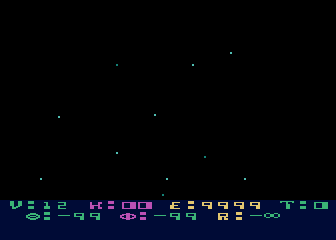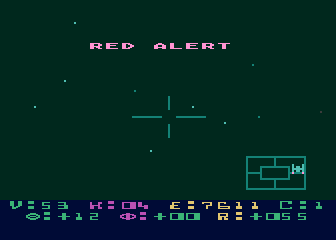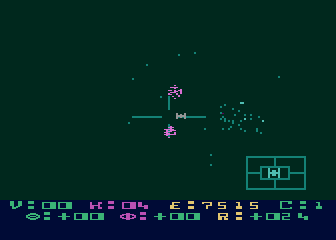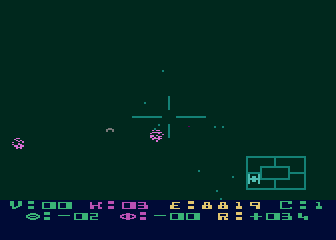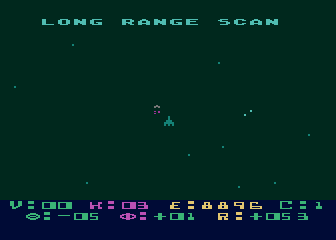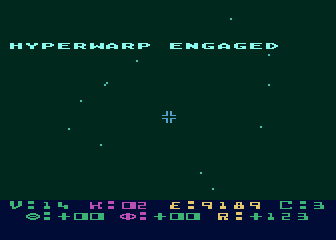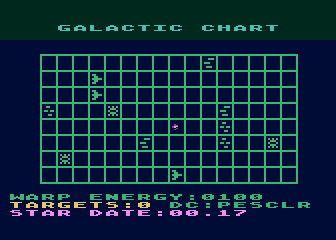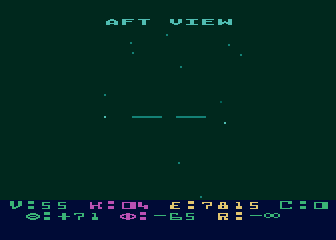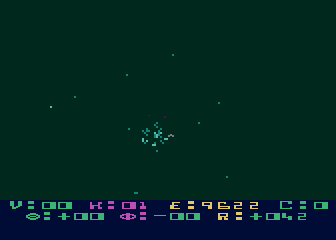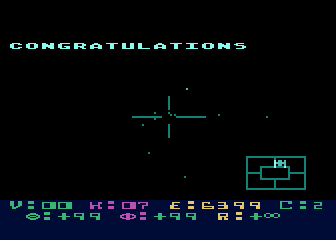|
|
Star Raiders
|
Name:
|
Star Raiders |
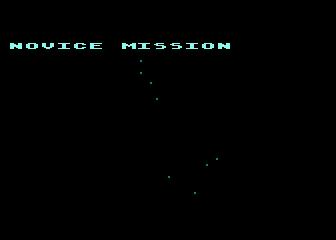 |
| Company: | Atari | |
|
Model #:
|
CX-5205 | |
|
Programmers:
|
Atari 8-Bit Version: Doug
Neubauer Atari 5200 Port: Joe Copson |
|
| Year: | 1982 | |
|
Released?
|
Yes
|
|
|
Notes:
|
Star Raiders has the largest manual of any 5200 game (38 Pages) |
Star Raiders... The game that single handedly sold more Atari 400/800's than any application ever could. When people by a $600 or $1200 system just to play one game you know it has to good. Upon its release in 1980 Star Raiders amazed the world with it's combination of Star Wars and Star Trek. No game before had ever before so caputred the imagination of nerds and geeks everywhere. If Atari was looking for a killer game for its new computer system, this was it.
After enjoying two years of unprecedented success, Atari decided to port Star Raiders to it's new 5200 super system. Although Star Raiders was old news by this point, the game was still popular with many sci-fi/computer geeks. Since the 5200 was pretty much the same as the Atari 400/800 the port was basically identical except for the controls. However programmer Joe Copson took the time to clean up some bugs that were present in the original version and even added a few new features. The biggest differences between the two versions are:
| - The Atari 400/800 version always says "Star Cruiser 7
was destroyed by Zylon fire" when you die even if you were
destroyed by an asteroid. The 5200 version fixed
this by shortening this to "Star Cruiser 7 was destroyed". |
| - The Atari 400/800 version used different icons for
your current position and target sector on the galactic
map. The 5200 version also updates the Star Base
icons. |
| - The Atari 400/800 version had digital control, while the 5200 version fully supported the 5200's analog sticks. |
| - In the Atari 400/800 version players had to manually switch to Fore View once hyperspace is engaged on the Galactic Chart. In the 5200 version the game switches to Fore View automatically. |
One major advantage the 5200 had over the 400/800 was the keypad. One the Atari 400/800 players had to reach over and push keys on the keyboard to access the ships functions. Normally this wasn't a problem, but when there's a Zlyon ship on your tail the time it takes to reach over and press the key could be deadly (not to mention you have to take one hand off the stick to press the key). With the 5200 keypad all the ships functions were at your fingertips and could be accessed quickly with little effort.
Although Star Raiders looks complex at first glance, much of the game is pretty much common sense (turn on your shield, bring up the map, hyperwarp to the desired sector, etc). While it may have been new and mysterious back in 1980, it's pretty standard fare in this day and age. With the help of a the keypad overlay most of the games functions can be mastered in a few minutes.
The main functions on the keypad are Fore View, Aft View, Scan, Galactic Chart, Tracking, Shields, Attack, Hyperspace, Manual, and speed control. Fore and Aft view change your main view from fore (in front of your ship) to aft (behind your ship). Scan turns on your long range scanners (giving you an overhead view of the whole sector). Galactic Chart brings up the galactic map. Tracking turns on your tracking computer, this locks onto the enemy target and moves your ship accordingly. Shields raises and lowers your shields (don't ever mess with this button). Attack turns on your attack computer (the crosshairs) and the targeting display (the little box in the lower right). Hyperspace warps to the desired sector (selected from the galactic map screen). Manual allows you to manually choose which target you want to attack. Speed Mode lets you set your current speed (1-9).
The display at the bottom of the main screen may look like a mass of confusing numbers and letters, but it's pretty straightforward. V is your current velocity (speed), K is the number of kills you've made, E is your current energy, T is the current object your tracking computer is tracking (this becomes a C if you have your combat computer on). The little ovals on the next line represent your current horizontal and vertical positions in the sector, while R shows the targets current range from your ship.
The Galactic Chart screen displays the current locations of enemy and friendly units across the galaxy. The Galactic Chart also displays vital diagnostic information about your ship. The letters DC: PESCLR stands for Damage Control: Proton Launcher, Engines, Shields, Computer, Long Range, and Radio. If the letters are displayed in blue you're in good shape, but if any of the letters are yellow or red then one of your systems have been damaged. Depending on the system and the extent of the damage (yellow is damaged but working, while red is destroyed) this can affect your ship in all kinds of ways (flickering shields, slow movement, hard steering, scanner failure, etc.). To repair a damaged system you'll have to dock with a Star Base.
Star Bases appear in several sectors of the map, and are prime targets for Zylon forces. Pay attention to your subspace radio and make sure that when a Star Base comes under attack you get to that sector quickly. If Zylon forces destroy a Star Base you'll loose its services for the rest of the game (and you'll need them!). To dock with Star Base for repairs or refueling line up the base in your sight and make sure your horizontal and vertical coordinates are at + or - 3. Slowly approach the Star Base until the distance reads 0, then cut your engines. If all went well you'll get a message say "Orbit Established" and a little ship will come out, if not try again.
The Galactic Chart also allows you to choose your hyperwarp destination. By moving the cursor to a new sector on the map and pressing the hyperwarp button, you will begin the hyperwarp process. The amount of energy the hyperwarp will take is displayed at the bottom of the screen as Warp Energy (make sure you have enough!). Unfortunately for you, Hyperwarping isn't an exact science. You're going to have to steer your ship through out the jump. To steer, make sure you keep the warp icon lined up between your crosshairs until the warp ends. If you didn't keep it lined up you may end up in a different sector than you planned.
The rest of the game is pretty simple. Hunt down and destroy all the Zylon ships in the galaxy. There are three different types of ships that you'll encounter: Fighters, Cruisers, and Basestars.
| Fighters | |
These little guys look like Tie-Fighters and are the most common of the three ship types. Fighters are fast and hard to target, but go down in one hit. Fighters will be your main enemy throughout the game. |
| Cruisers | |
Cruisers are patrol ships which resemble a large purple lowercase n. Cruisers will only attack in self-defense, but they can be deadly if annoyed as they pack more of a punch than the normal fighters. |
| Basestars | |
These mobile battle fortresses come equipped with shield generators enabling them to withstand several hits. Basestars can only be attacked at close range, so use extreme caution when approaching them. |
Depending on how you do, you will be assigned a rank at the end of the game. The game will end when you either destroy all the Zylon forces, run out of energy, or get destroyed. Your rank is based on several factors such as number of enemies destroyed, amount of time taken, number of Star Bases destroyed, and amount of energy remaining. While Star Raiders can be easily beaten, getting the higher ranks will take lots of practice.
Much like its 400/800 counterpart, Star Raiders was one of the top reasons to own a 5200. Star Raiders proves that even games that were keyboard dependant could easily be ported to the 5200. The analog joystick with its built in keypad seems like it was made just for this game. Star Raiders ranks in the top 10 of most peoples favorite 5200 games, and belongs in every owner's library.
| Version | Cart Text | Description |
| 2/23/83 | Praid Crt PAL 2/23/83 | Pal version |

